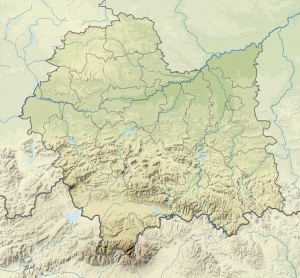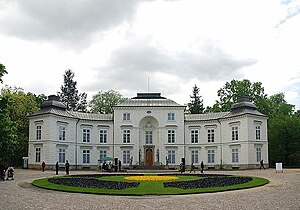Myślewicki Palace
| Myślewicki Palace | ||
|---|---|---|
|
Garden facade |
||
| Creation time : | 1775 | |
| Castle type : | Palace | |
| Conservation status: | Reconstructed | |
| Place: | Warsaw | |
| Geographical location | 52 ° 12 '55.9 " N , 21 ° 2' 17.7" E | |
|
|
||

The early classical Myślewicki Palace (Polish: Pałac Myślewicki ) in Warsaw is located in Łazienki Park and dates from the 18th century. The small, architecturally interesting palace housed important politicians as a guest house for Polish governments.
The palace is located at the end of the Ulica Myślewiecka feeder road outside the park , which joins the park at Agrykola ulica (now a pedestrian zone). The Łazienki Palace is around 150 meters to the west . In front of the Myślewicki Palace there is a small roundabout, on the southern side of which there is the Great Office , created by Tylman van Gameren , also known as the Ensign School (Polish Podchorążówka ). Around 200 meters south of the palace in Łazienki Park are the buildings of today's Hunting and Equestrian Museum .
history
The name of the palace refers to the village of Myślewice, which was once nearby. The building was erected for Stanislaus II August Poniatowski ; it was one of the first buildings in his Łazienki Park. The royal builder Dominik Merlini built the palace in three phases from 1775 to 1778. First, the core building was erected on a rectangular floor plan. Later, side pavilions were built, which were finally connected to the main building.
Although originally intended as living space for higher officials of the royal court, the palace was taken over by the king's nephew, Józef Antoni Poniatowski , as early as 1779 . From the 19th century the building was used as a guest house by the respective Polish governments. Napoleon Bonaparte lived here . Generals from Russian units stationed in Warsaw later took quarters here. In the period between the world wars, General Bolesław Wieniawa-Długoszowski and statesman Eugeniusz Kwiatkowski lived in the palace . As one of the few such objects in Warsaw, the palace was not destroyed during World War II.
During the time of the People's Republic of Poland , official visitors from abroad were accommodated in the building. They included Indira Gandhi and Richard Nixon . On September 15, 1958, the historically significant first meeting between ambassadors of the USA and the People's Republic of China took place in the palace . Other such meetings were held here until 1972. Since 1980 he has been part of the palace and park ensemble of the Royal Łazienki Park Museum.
architecture
The building follows the plan of a wide horseshoe. It consists of a three-storey central building with a high, dominant entrance niche (which runs through all storeys), two quarter-circle round wings that terminate in - likewise rectangular - pavilions. The roof is reminiscent of Chinese constructions. When designing the facades, elements of the Rococo were combined with the style of early classicism. In niches at the entrance there are two sculptures of the flora and the zephyr created by Jakub Monaldi . In the half-dome of the high entrance niche, Jozef Poniatowski's initials are contained in a round cartouche.
In the interior of the palace, the original furnishings have largely been preserved. These include paintings by Jan Bogumił Plersch and Antoni Gerżabka, ornaments and stucco . The dining room with views of Rome and Venice and an old bathroom are particularly worth seeing.
literature
- Julius A. Chroscicki and Andrzej Rottermund: Architectural Atlas of Warsaw . 1st edition, Arkady, Warsaw 1978, p. 92
- Marek Kwiatkowski: Łazienki and Belvedere . Arkady-Verlag, ISBN 83-213-3099-1 , Warsaw 1986, p. 14 f.
- Janina Rutkowska: City Guide Warsaw . 2nd edition, Verlag Sport i Turystyka, Warsaw 1972, p. 95
Web links
- Detailed description on the website of the Łazienki Park (in English)
- Information on the palace at WarsawaWikia (in Polish)
- Brief information about the palace on the website of the City of Warsaw (in Polish)
See also
References and comments
- ↑ according to Małgorzata Danecka, Thorsten Hoppe: Discover Warsaw. Walking tours through the Polish capital. Trescher Verlag, Berlin 2008, ISBN 978-3-89794-116-8 , p. 184
- ↑ Monaldi Jakub (1730–1798) was an Italian sculptor who worked at the Polish court
- ^ Jan Bogumił Plersch (1732-1817) was a Polish painter and plasterer of German descent



